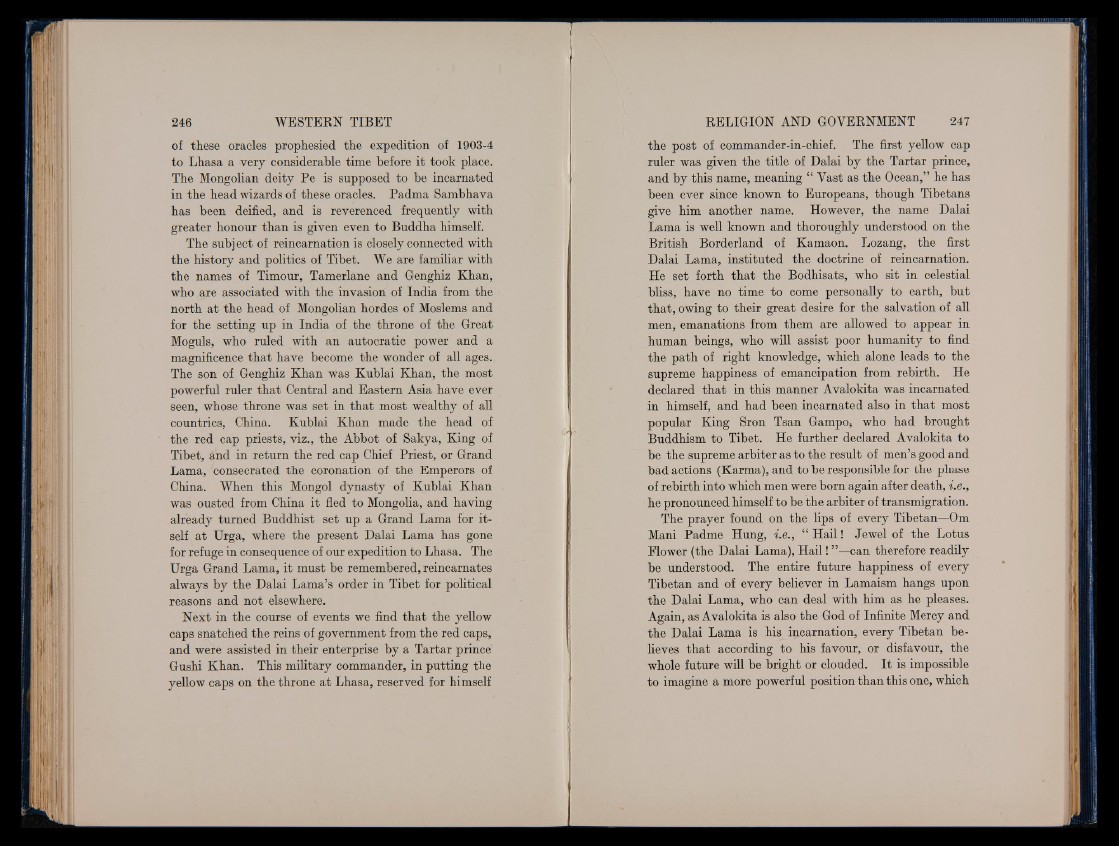
of these oracles prophesied the expedition of 1903-4
to Lhasa a very considerable time before it took place.
The Mongolian deity Pe is supposed to be incarnated
in the head wizards of these oracles. Padma Sambhava
has been deified, and is reverenced frequently with
greater honour than is given even to Buddha himself.
The subject of reincarnation is closely connected with
the history and politics of Tibet. We are familiar with
the names of Timour, Tamerlane and Genghiz Khan,
who are associated with the invasion of India from the
north at the head of Mongolian hordes of Moslems and
for the setting up in India of the throne of the Great
Moguls, who ruled with an autocratic power and a
magnificence that have become the wonder of all ages..
The son of Genghiz Khan was Kublai Khan, the most
powerful ruler that Central and Eastern Asia have ever
seen, whose throne was set in that most wealthy of all
countries, China. Kublai Khan made the head of
the red cap priests, viz., the Abbot of Sakya, King of
Tibet, and in return the red cap Chief Priest, or Grand
Lama, consecrated the coronation of the Emperors of
China. When this Mongol dynasty of Kublai Khan
was ousted from China it fled to Mongolia, and having
already turned Buddhist set up a Grand Lama for itself
at Urga, where the present Dalai Lama has gone
for refuge in consequence of our expedition to Lhasa. The
Urga Grand Lama, it must be remembered, reincarnates
always by the Dalai Lama’s order in Tibet for political
reasons and not elsewhere.
Next in the course of events we find that the yellow
caps snatched the reins of government from the red caps,
and were assisted in their enterprise by a Tartar prince
Gushi Khan. This military commander, in putting the
yellow caps on the throne at Lhasa, reserved for himself
the post of commander-in-chief. The first yellow cap
ruler was given the title of Dalai by the Tartar prince,
and by this name, meaning “ Vast as the Ocean,” he has
been ever since known to Europeans, though Tibetans
give him another name. However, the name Dalai
Lama is well known and thoroughly understood on the
British Borderland of Kamaon. Lozang, the first
Dalai Lama, instituted the doctrine of reincarnation.
He set forth that the Bodhisats, who sit in celestial
bliss, have no time to come personally to earth, but
that, owing to their great desire for the salvation of all
men, emanations from them are allowed to appear in
human beings, who will assist poor humanity to find
the path of right knowledge, which alone leads to the
supreme happiness of emancipation from, rebirth. He
declared that in this manner Avalokita was incarnated
in himself, and had been incarnated also in that most
popular King Sron Tsan Gampo, who had brought
Buddhism to Tibet. He further declared Avalokita to
be the supreme arbiter as to the result of men’s good and
bad actions (Karma), and to be responsible for the phase
of rebirth into which men were born again after death, i.e.,
he pronounced himself to be the arbiter of transmigration.
The prayer found on the lips of every Tibetan—Om
Mani Padme Hung, i.e., “ Hail! Jewel of the Lotus
Flower (the Dalai Lama), H ail! ”—can therefore readily
be understood. The entire future happiness of every
Tibetan and of every believer in Lamaism hangs upon
the Dalai Lama, who can deal with him as he pleases.
Again, as Avalokita is also the God of Infinite Mercy and
the Dalai Lama is his incarnation, every Tibetan believes
that according to his favour, or disfavour, the
whole future will be bright or clouded. It is impossible
to imagine a more powerful position than this one, which